Spitfire MK.XVI
Dual Combo Limited Edition

Eduard, 1/72 scale
S u m m a r y : |
Catalogue Number: |
Eduard Kit No. 2117 - Spitfire MK.XVI Dual Combo Limited Edition |
Scale: |
1/72 |
Contents & Media |
218 grey and nine clear styrene parts, two coloured PE frets totalling with 64 parts, a pre-cut Kabuki tape canopy mask, and decals for eight markings options. |
Price: |
Available on-line from these stockists:
Click for currency conversion. |
Review Type: |
First Look. |
Advantages: |
The best 1/72 Spitfire Mk.XVIs; very accurate, great detail, good options, and terrific value. |
Disadvantages: |
None noted. |
Conclusion: |
Eduard’s Spitfire Mk.XVIs are the best in “The One True Scale” by a long measure, and is a superb example of the kit maker’s art. This high-back & bubble-top “Dual Combo Limited Edition” represents great value and cannot recommend it highly enough. |
Reviewed by
Mark Davies

Eduard’s 1/72 Spitfire F Mk.XVI Dual Combo is available online from Squadron.com
In the early months of 1942, with the clear superiority of the Focke Wulf Fw 190 over the Spitfire VB, there was much pressure to get Spitfires into production using the new two-stage supercharged Merlin 61 engine. In September 1941 the Spitfire Mk.III prototype N3297 had been converted by Rolls-Royce at their Hucknall plant to take a Merlin 60, which had been specifically designed for use in the Wellington Mk.VI high altitude bomber.
The performance increase was described by Jeffrey Quill as a "quantum leap" over that of the Mk.VB and another Spitfire airframe, R6700 was modified to take the new engine. Although design work on the Mk.VII and VIII series was under way, these would take over a year to get into production and a counter to the Fw 190 was urgently needed.

The Air Ministry made the decision that Mk.VC airframes should be converted to take the more powerful engine and, as a result, many of the early IXs were converted Mk.VCs which did not have any of the refinements which later appeared. These could be identified by the Type C wing with the large double blisters over the inner cannon bays and the identification light on the fuselage spine, behind the aerial mast. The elevator horns were also smaller in size than that of most Mk.IXs which had larger horn balances. The first IX was a modified VC AB505, which was tested by the Air Fighting Development Unit (AFDU) in April 1942. The report said:
The performance of the Spitfire IX is outstandingly better than the Spitfire V especially at heights above 20,000 feet. On the level the Spitfire is considerably faster and climb is exceptionally good. It will climb easily to 38,000 feet and when levelled off there can be made to climb in stages to above 40,000 feet by building up speed on the level and a slight zoom. Its manoeuvrability is as good as a Spitfire V up to 30,000 feet and above is very much better. At 38,000 feet it is capable of a true speed of 368mph and is still able to manoeuvre well for fighting.
Although the Mk.IX's airframe did not have the aerodynamic and strength improvements, or the modified control surfaces of the Mk.VII and VIII, the Mk.IX still proved to be an effective counter to the Focke Wulf Fw 190.
Production of the Mk.IX finished at Supermarine in June 1943, with production continuing exclusively at the Castle Bromwich factory. Several major and large numbers of minor improvements were progressively introduced to Mk.IXs, some of which were used on other Spitfire variants.
The Merlin 61 was phased out early in 1943 in favour of the Merlin 63 and 63A. The new engine had increased power resulting from engine improvements. During the second half of 1943, production of the Merlin 63 powered F Mk.IX was discontinued in favour of the Merlin 66 powered LF Mk.IX. Early production Spitfire IXs suffered from vapour locks in the fuel lines resulting from fuel evaporating if the aircraft was parked in direct sunlight. As a result of this the gun-camera was moved from the port wing root to the starboard wing root and a fuel cooler, fed by a small round air-intake was fitted in its place. This fuel cooler was also fitted to early PR Mk.XIs.
Production of the LF Mk.IXs, frequently referred to as the Spitfire IXB, initially ran in parallel with the Merlin 63 powered Marks. This version first became operational in March 1943 with the Biggin Hill Wing, comprised at the time of 611 and 341(Free French) Squadrons. This type was by far the most produced of the Spitfire IX variants, with over 4000 built. The maximum power of the Merlin 66 was 1,720 at 5,750 ft and the maximum speed of the Spitfire LF IX was 404 mph at 21,000 feet. The Merlin 66 introduced a new Bendix-Stromberg injection carburettor, which replaced the earlier S.U float carburettor.
The H.F IX was powered by the specialised high altitude Merlin 70 and entered service in the spring of 1944. Serial listings show that the HF Mk.IX was produced in relatively limited numbers when they were required, with priority being given to versions rated for low and medium altitudes. Maximum power of the Merlin 70 was 1,710 hp at 11,000 ft. Maximum speed of the Spitfire HF.IX was 405 mph at 25,400 feet at an all-up weight of 7,320 lb.
Also introduced in early 1944 was a new Mark II Gyro gun sight. This gun sight calculated the correct angle of deflection to use when leading the target. Its introduction doubled the effectiveness of RAF gunnery and was a major factor in Allied air superiority.
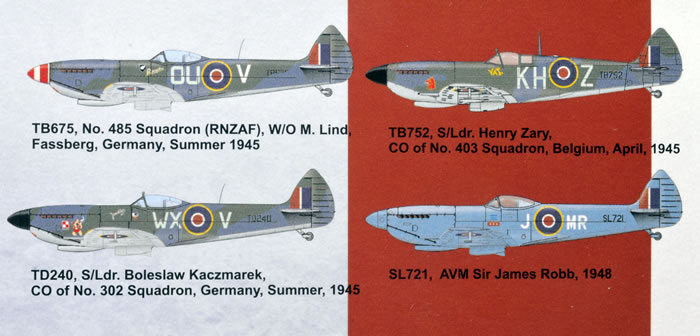
The capacity of the main fuel tanks was 48 gal for the upper tank and 37 gal for the lower, for a total internal capacity of 85 gal. Jettisonable "slipper tanks" of 30, 45 or 90 gal could be carried under the centre-section. As an alternative a cylindrical 50 gal drop tank, adapted from those carried by long range Hawker Typhoons could be carried on the fuselage bomb rack used on most Mk.IXs of the Second Tactical Air Force.
To further increase the combat radius some late production Mk.IXs were fitted with additional internal self-sealing fuel tanks in the rear fuselage: the upper tank carried 41 gal and the lower 34 gal. When both were full this enabled a ferry range of over 1,200 miles, although they made the aircraft unstable in flight and only straight flight and gentle manoeuvres at low altitudes were recommended by the pilot's manual. The pilot was also warned to avoid instrument flying whenever possible.
Late production Mk.IXs, in common with Mk.XVIs introduced a new upper engine cowling which incorporated a distinct bulged top surface; this design was adopted for the Mk.XVI to allow for the modified intercooler of the Packard Merlin 266, which had an integral header tank.
The cut-down rear fuselage and bubble canopy, trialled on a Spitfire Mk.VIII, was incorporated into very late production Mk.IXs. With the cut down fuselage the lower forward fuselage tank capacity was increased to 47 gallons, while the rear fuel tanks were decreased to a capacity of 66 gallons. These were the rarest of the Mk.IXs and many of them featured the "clipped" wings. The great majority of these saw post-war service with the SAAF, both in South Africa and in deployment in Korea during the 1950s.
Source: Wikipedia
Previous 1/72-scale Spitfire Mk.XVI Kits
I will include Mk.IXs as externally they are identical to Mk.XVIs with the same wing type.
There has been quite been a lot of 1/72 Spitfire Mk.IX kits over the years with just a few boxed as Mk.XVIs. Only Heller, CMR and Sword have offered bubble-tops. All are injected kits unless otherwise noted. I will ignore the very few TR.9 and other two-seat Mk.IX kits and focus on single-seaters.
The first was by Airfix in 1960 or possibly Lindberg (1/75-scale), followed in no particular order by Frog (re-boxed by Intech), Cruver, Lotnia, LB Models (resin), Matchbox, KP (re-boxed by Mastercraft Models), Esoteric (resin), Ventura, Heller (bubble-top), Hasegawa, Italeri, and CMR (resin with various high and bubble-top boxings). I have also read of the existence of a Mk.IX by Monogram, but have no other information about it. More recently, there have been new releases by Airfix, Sword and AZ Model. I felt that the Airfix kit was a disappointment with too many faults, whilst the Sword and AZ Model kits both offered excellent kits in both high and bubble-top versions.
For a long time I considered CMR’s kits to be the best overall because of their accuracy, options and attention to detail, followed by the Sword and AZ Model injected kits, which leave little to choose between them, although I personally favour AZ slightly. But as anyone who has read reviews of the new Eduard Mk.IX kits already knows, all previous kits have now been thoroughly bettered.
The Contents
The parts come in a top-opening box and are enclosed in re-sealable cellophane bags, with the clear sprues, PE frets, canopy masks and decals each in their own separate bags.
The instruction booklet is printed in colour on glossy paper, with clear and easy to follow drawings. These can be viewed or downloaded from Eduard’s website by clicking here. Colour call-outs are cross referenced to Gunze Sangyo’s Aqueous and Mr. Color paint ranges, and include RAF names for the camouflage colours.
This boxing and its markings represent a Mk.XVIe high-back and bubble-top; however, also included are parts applicable to earlier Mk.IXs as well as the Mk.VII and VIII. These are surplus to requirements as the parts map indicates:
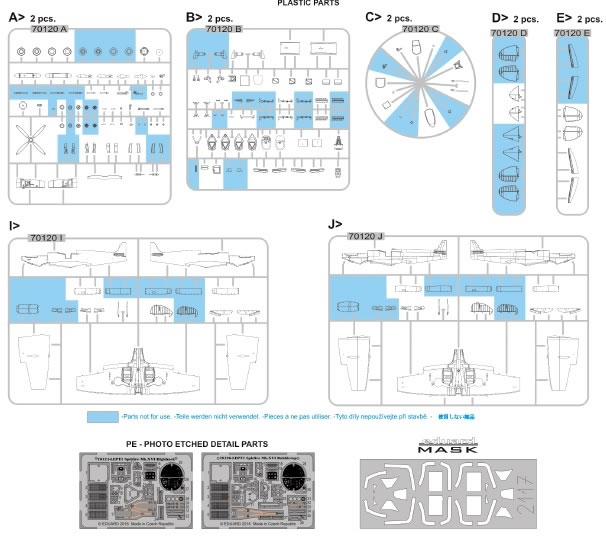
The moulding of the ten grey airframe sprues is flawless, with super-crisp and delicate detail, narrow sprue gates, and thoughtfully positioned ejector pins. The two clear sprues are likewise flawless with thin and clear parts; whilst the PE fret and paint-mask are also produced to Eduard’s usual high standards.
The Kit
Due to many of the parts being shared in common I shall generally use the singular “kit” when describing the kits, but will identify specific high-back or bubble-top features as necessary.
The first thing that struck me was the delectable surface detail this kit exhibits. It has ultra-fine and consistent recessed panel lines, and has some of the best rivet detail I have encountered in the scale. Rivets have come back into modelling fashion, but unlike many brands following this trend, Eduard has managed to keep theirs unobtrusive and in the right places. The accompanying parts images tend to emphasise them due to the bright lighting used, whereas under normal lighting all but disappear depending on the angle the parts are viewed from. Where applicable, the fabric control surfaces are correctly portrayed as being drum-tight, with rib-tapes that again appear more prominent in the images than they actually are.
There is not a lot of room in a Spitfire’s cockpit in this scale, but Eduard has made a very nice job of things. They have adopted a slightly unusual approach for 1/72 scale spitfires by moulding the sidewall detail below the level of the pilot’s door on separate inserts, as opposed to integrally with the fuselage halves. This makes sense as it matches the method used for Eduard’s Brassin resin and PE cockpit set sold separately; making the kit and Brassin parts readily interchangeable.
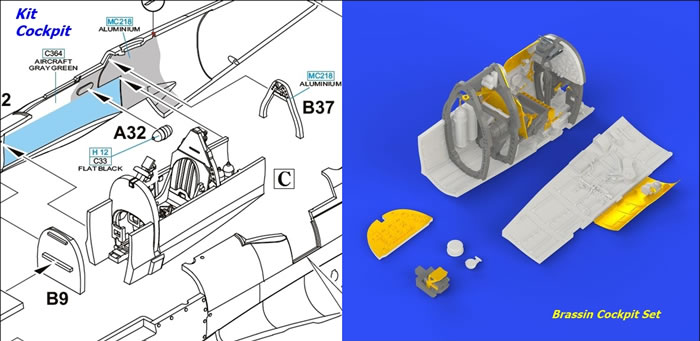
Coloured PE garnishes the seat with a coloured PE harness, and also replaces the moulded compass repeater below the instrument panel. There is choice of instrument panels; one has raised detail and optional instrument decals, and the other is smooth to accept the very nice coloured PE instrument detail.
There is a choice of fuselage frame behind the pilot’s seat for both the high-back and bubble-top kits; in each case one option requires the addition of PE head armour, whilst the other has the armour moulded in place and requires the tiny slot for the harness to be opened up. The frame with the amour moulded in place is obviously suited to pending Weekend Editions that will lack a PE armour option, but why they are included as an option in the Dual Combo instructions is unclear to me. Four high-back frames are provided; as two mount the characteristic voltage regulator behind the armour that was a carry-over feature from the Mk.V that does not apply to later Mk.IXs and the Mk.XVI, so make sure you select the right one.
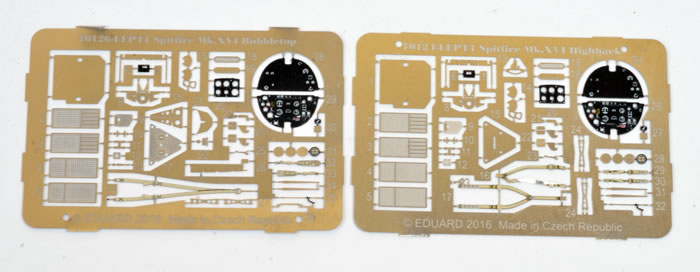
Various other PE parts all add to the high detail levels moulded detail provided; some are quite small, such as the brake lever that fits to the control column handgrip. There is also a gun-sight is moulded in clear.

The canopies are nice and clear with the optional parts for open or closed presentation, and it obviously here that the two kits differ most:
- High-back. There are three pilot’s entry doors, two providing open or closed options to be used in conjunction with an open canopy, and another closed one to be used with the closed canopy. A closed canopy requires a small section of canopy rail to be removed from each fuselage half in order for the closed canopy to fit properly. Care will be needed when removing these quite small areas, but it has enabled Eduard to provide a very realistic appearance to the canopy rails with either open or closed canopies.
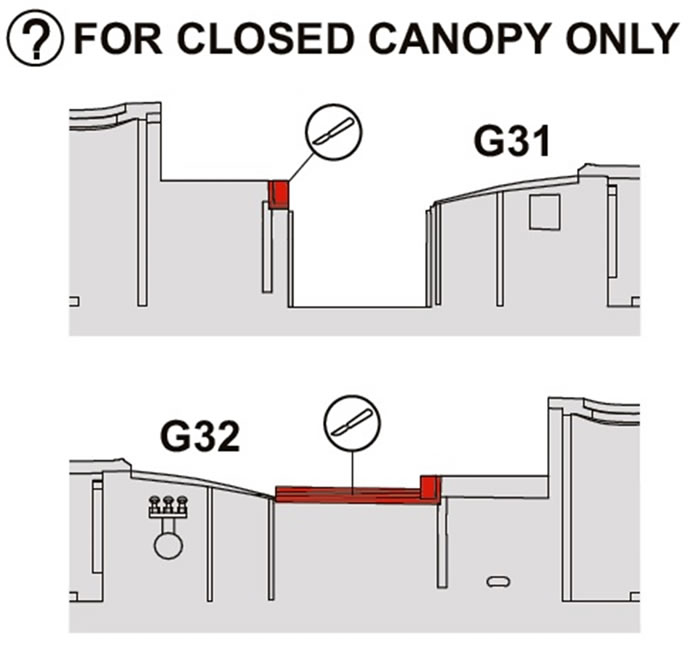
- Bubble-top. The bubbletop does not require any surgery to the cockpit sills, but does require and internal addition to the cockpit. Bubble-tops were opened from inside the cockpit suing a crank that turned a chain drive drew the canopy back and forward on its rails. The chain was enclosed by an angled cover running along the starboard cockpit sidewall, with the crank handle at its forward end. Eduard provides this as a PE part that must be folded into shape. As an aside, bubble-tops had a small circular panel on the exterior just below the windscreen that depressed to disengage the chain drive and enable the canopy to be pushed open. Pleasingly, Eduard has included this panel.
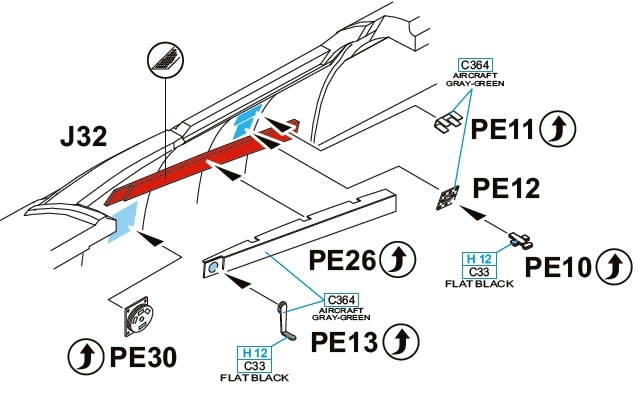
Different style internal rear-view mirrors to mount inside the high-back’s and bubble-top’s windscreen are included as PE parts, whilst the common clear styrene external rear-view mirror mounts on top of the windscreen of each. A pre-cut canopy mask is included, this being the equivalent of a Profipack Edition.
The fuselage halves enclose the cockpit assembly, and have separate upper and lower cowl parts, as well as separate forward wing-roots. This added complexity is to accommodate variations across other boxings that include three styles of upper cowl, two lower cowls with early and late style carburettor intakes (the later long type applying to the Mk.XVI); whilst the two wing-root styles allow for the later port to starboard switch of the gun camera, made necessary by the incorporation of a fuel-cooler to cure vapour locks. The kit includes additional internal support in the nose area of the fuselage halves to ensure that good fit is not compromised by the multi-version/multi-part approach adopted.
As per the originals, there is a small brace to fit between the frame carrying pilot’s head armour and the fuselage frame at the rearmost part of the canopy for the high-back; and a choice of moulded or PE brace and panel for the bubble-top.
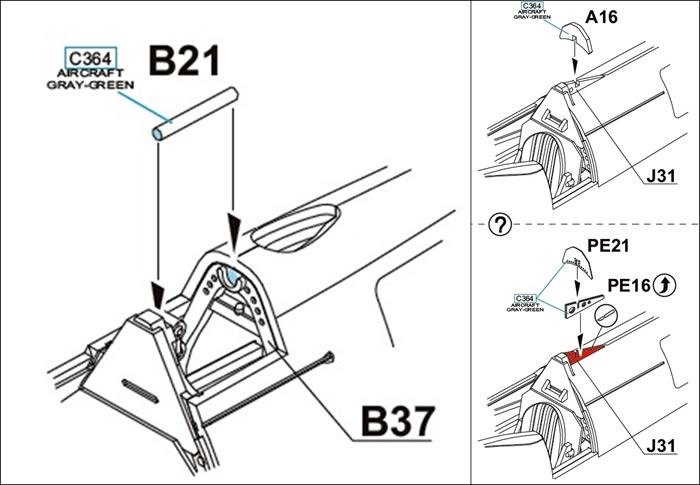
The wings are split between their upper and lower surfaces as you would expect. The upper surfaces with this boxing feature the slim bulge over the outboard cannon bay, as applicable to E-wing aircraft. Sandwiched between the wing halves are a portion of main spar and undercarriage bay walls. The wingtips are separate in keeping with the need to offer three tip styles across multiple versions in other boxings; with a very nice touch being the clipped wingtips being moulded in clear styrene to account for the navigation-lights.
Likewise, the early rounded and pointed rudders are separate parts, with the pointed style applying to the review kit. The early and late style ailerons are also separate from the wings, whereas the elevators are fixed to the horizontal stabilizers; although three types of tailplane are supplied, with early large-horn balance metal skinned elevators applicable to the review kit, whilst small and large-horn fabric styles are surplus.
Eduard has adopted an unusual (for this scale at least) multipart approach to the radiator/intercooler housings. The sides are separate from the bottom panel, which has enabled detail to be moulded on both sides, which is a real plus if the separate vent panels are positioned fully lowered. The radiator/intercooler matrix is moulded with the lower wing sitting inside well represented ducting. The matrix faces are supplied as PE parts (I suspect that these will be supplied as decals in Weekend Editions).
The mouth of starboard radiator housing has a small PE pipe representing the end of the fuselage fuel tank vent pipe. It runs from the wing underside into the face of the coolant radiator’s matrix* (see photo below for the real thing). Some may prefer to replace the kit’s PE part with lead wire to give a more authentic appearance.
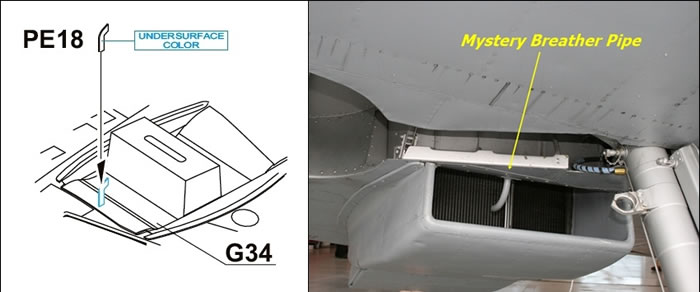
* In service the Spitfire’s fuel tanks were pressurised with regulated vacuum pump exhaust air to prevent the fuel in the tanks from boiling and vaporising at high altitudes. If the fuselage fuel tanks got punctured continued pressurisation was not recommended as this would work against the self sealing compound trying to seal the leaks; so the pilot would change from pressure venting to normal venting by switching a cock in the cockpit, which then redirected the vacuum exhaust air vent to the atmosphere. The outlet for this redirected vacuum exhaust air is that little vent pipe at the front of the starboard radiator. Most restored Spitfires have the pressure venting cock locked in the "normal venting" position as pressurising of the fuel tanks is not necessary. (Note: For Griffon-powered Spitfires the pipe is at the rear of the port radiator).
The instructions advise which of three styles of main undercarriage leg supplied is to be used; along with three-spoke main wheels (surplus five and four-spoke are also included) are split between the spoked face and brake drum. The tyres are split, presumably to reduce the risk of sink-marks, and once assembled can have the wheel rims fitted after painting. The tail-wheel and its leg is a simple on-piece item, as expected.
Three styles of external fuel tank are included with this boxing; a cigar-style with rack and PE sway braces, and two sizes of slipper tank (60 & 90 Gallon) with PE locating hooks. Underwing 250lb bombs and their racks are also included (late Merlin-engined Spitfires being widely used a as fighter-bombers, whilst Griffon-engined Mk.XIVs took care of air superiority).
Fish-tail exhausts are indicated by the instructions, although later round exhausts are included as well; and these can be fitted after painting is complete. Not much remains to mention assembly-wise, the cannons and .50 cal machine gun muzzles (make sure you use the shorter cannon barrels), underwing pitot, fuselage fuel-tank filler cap, a very refined four-blade prop with separate spinner, antenna mast with separate base, and clear teardrop dorsal light.
Of course, Eduard specialises in aftermarket details and accessories; and in the case of the Spitfire Mk.IX there are numerous sets well worth checking out at Eduard’s website.
Colours & Markings
The decals provide for three high-back and five bubble-top markings options, along with quite extensive stencilling.
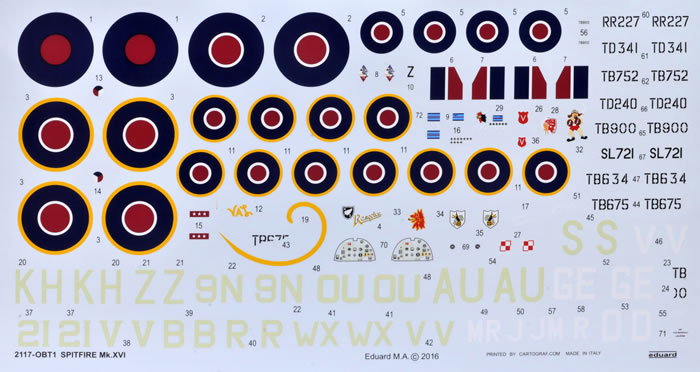
Each scheme is illustrated in colour with a single page of four-view drawings, whilst the stencil locations are identified in a separate page of their own.
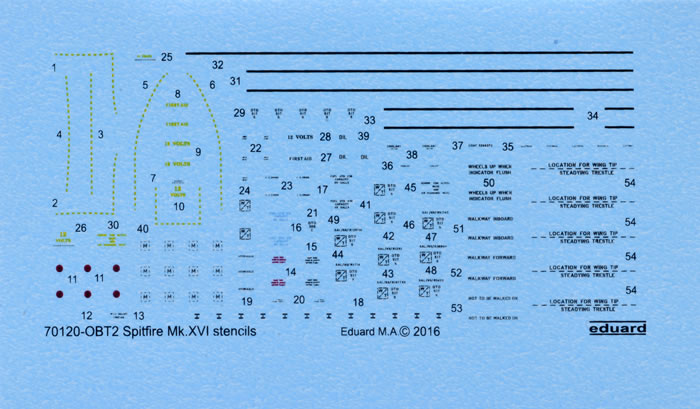
The bubble-top machines covered are:
- TB900 / GE-D, No.349 Squadron, Wunstorf, Germany, summer 1945;

- TD341 / 21-V, No.443 Squadron, Utersen Airfield, Germany, August 1945;

- TB675 / OY-V, flown by WO M. Lind, 485 Squadron (RNZAF), Fassberg, Germany, summer 1945;

- SL721 / MR-J, flown by AVM Sir James Rob, 1948; and

- TD240 / WX-V, flown by Sqn Ldr Boleslaw Kaczmarek, OC No.302 Squadron, Varrelsbuch Airfield, Germany, summer 1945.

The high-back machines covered are:
- RR227 / 9N-R, flown by Sqn Ldr Otto Smik, OC No.127 Squadron, Grimbergen Airfield, Belgium, November 1944;

- TB634 / AU-S, flown by PO A.F. McIntosh, No.421 Squadron (RCAF), B.90 Airfield Petit Brogel, Belgium, March 1945; and

- TB752 / KH-Z, flown by Sqn Ldr Henry Zary, OC No.403 Squadron, Belgium, April 1945.

The decals appear to be of excellent quality, with crisp registration and good colouration.
Eduard’s Spitfire Mk.XVIs are the best in “The One True Scale” by a long measure, and is a superb example of the kit maker’s art. This high-back & bubble-top “Dual Combo Limited Edition” represents great value and cannot recommend it highly enough.
Thanks to Eduard for the sample
Review Text and Images Copyright © 2017 by Mark Davies
Sprue Photos Copyright © 2017 by Brett Green
Page Created 8 March, 2017
Last updated
8 March, 2017
Back to HyperScale Main Page
Back to Reviews Page |
